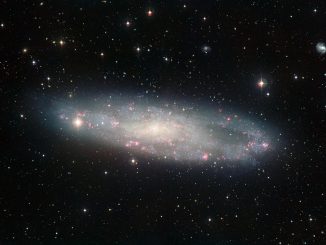Astronomers using the Hubble Space Telescope to study a supernova remnant in the Small Magellanic Cloud have determined light from the blast reached Earth 1,700 years ago during the decline of the Roman Empire. While it would have been visible to inhabitants of the southern hemisphere, there are no known records of any observations. Located some 200,000 light years away, the remnant is known as 1E 0102.2-7219. As shown below, gaseous knots in the expanding cloud of debris that are headed in Earth’s general direction are shown in blue while those moving away appear read. The cloud is expanding at an average speed of 3.2 million kilometres per hour, or 2 million mph. By measuring the motions of 22 clumps of oxygen-rich clumps of debris, researchers were able to determine when the supernova must have occurred. Likewise, they estimated the collapsed neutron star created in the blast must be moving at more than 3 million kilometres per hour.

A Hubble/European Space Agency video shows the supernova remnant in context:



